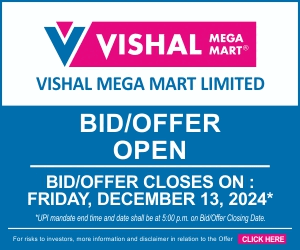Aurangabad-based Varroc Engineering plans to launch its IPO next week and has priced the offer in the range of INR965 – 967 per share. The IPO will involve sale of 20,221,730 shares through an Offer For Sale (OFS), amounting to INR1,955.4 crore at the upper end of the price end. Investors can place orders for minimum 15 shares and in multiples thereafter. All these shares of the auto component manufacturer will be sold by existing shareholders. While the positive response to recent IPOs of RITES Limited and Fine Organic Industries indicates the positive sentiment, it is better to check the fundamentals before committing your money and Varroc Engineering IPO review is a step in this direction.
|
Varroc Engineering IPO details |
|
| Subscription Dates | 26 – 28 June 2018 |
| Price Band | INR965 – 967 per share |
| Fresh issue | Nil |
| Offer For Sale | 20,221,730 shares (INR1,951.4 – 1,955.4 crore) |
| Total IPO size | 20,221,730 shares (INR1,951.4 – 1,955.4 crore) |
| Minimum bid (lot size) | 15 shares |
| Face Value | INR1 per share |
| Retail Allocation | 35% |
| Listing On | NSE, BSE |
Varroc Engineering IPO Review: All OFS
As mentioned above, all the shares sold in the IPO will be offered by existing shareholders and thus, the company will not get anything from IPO proceeds. Among the selling shareholders are Omega TC Holdings Pte Ltd, Tata Capital Financial Services Limited and promoter Tarang Jain.
Omega TC Holdings made an investment in the company in March 2014 which has resulted in its stake going up to 12.55%. The Singapore-based private equity firm plans to sell its entire shareholding of 16,917,130 shares. Similarly, Tata Capital Financial Services plans to sell its 1.15% equity stake or 1,552,040 shares. Tarang Jain, who currently owns 46.35% equity stake in the company, plans to offload 1,752,560 shares which will lead to his stake dropping to just above 45%.
Trivia – The average cost of acquisition of equity shares by Omega TC Holdings and Tata Capital Financial Services is INR162.43 per share. Good gains to be booked by private equity investors!
Varroc Engineering IPO Review: From two, three to four
The company is a manufacturer of exterior lighting systems, plastic and polymer components, electricals-electronics components, and precision metallic components. These components are used in passenger car, commercial vehicle, two-wheeler, three-wheeler and off highway vehicles.
Incorporated in 1988, the company was initially engaged in supplying components to Bajaj Auto – India’s leading two and three-wheeler producer. In the initial phase, the company grew organically but made strategic acquisitions in 2011 and 2012 of Triom and Visteon’s global lighting business, respectively that significantly expanded its global reach. The lighting business has since been renamed Varroc Lighting Systems and it remains a pillar of strength for the company, having Ford, Jaguar Land Rover, the Volkswagen Group, Renault-Nissan Mitsubishi, Groupe PSA and FCA as its key clients.
The company has strong and long-lasting relationships with key two-wheeler manufacturers such as Bajaj, Royal Enfield, Honda, Yamaha and Suzuki and also counts Hero, Piaggio and Harley Davidson among its customers. Despite its history in two and three wheeler segments, the company has expanded its business with four wheeler manufacturers and generated 63.8% of its consolidated total invoiced amount for FY2018 attributable from the latter segment.
Varroc has a global footprint of 36 manufacturing facilities spread across seven countries, with six facilities for its Global Lighting Business, 25 for India Business and five for Other Businesses.
Varroc Engineering IPO Review: On a strong financial footing
Since 2012, Varroc has invested in nine manufacturing plants in India apart from expanding reach in foreign market as a result of acquiring Visteon’s lighting business. This is visible in the company’s top line which grew in each of the last four years. From INR4,225.3 crore in FY2013, the company’s consolidated revenues expanded to INR10,417.1 crore in FY2018. While this is certainly incredible, a bigger story has played out on the profitability front as the company swung from a loss of INR25.4 crore in FY2013 to a profit of INR450.3 crore in FY2018. In these years, its net profit margin jumped from negative to 4.3%.
In the last few years, the company has taken several steps to reduce scrap at its facilities and make core manufacturing operations more cost-efficient. In addition, it has greatly reduced its borrowings which has helped in boosting margins. As of 31 March 2018, its net debt-to-equity ratio stood at 0.31, down from 0.53 in the previous year.
|
Varroc Engineering’s financial performance (in INR crore) |
||||||
| FY2013* | FY2014* | FY2015 | FY2016 | FY2017 | FY2018 | |
| Total revenues | 4,225.3 | 6,139.4 | 7,038.5 | 8,239.5 | 9,702.3 | 10,417.1 |
| Total expenses | 4,220.9 | 6,055.2 | 7,063.3 | 7,897.5 | 9,454.3 | 9,973.5 |
| Profit after tax | -25.4 | 42.0 | 13.0 | 369.0 | 303.0 | 450.3 |
| Net margin (%) | -0.6 | 0.7 | 0.2 | 4.5 | 3.1 | 4.3 |
* Figures for FY2013 and FY2014 are based on IGAAP and subsequent years are based on IND AS
Varroc Engineering IPO Review: Should you subscribe?
As seen so far in Varroc Engineering IPO Review, the company has done pretty much everything right. It has a solid business with big names as its customers, healthy growth rate and reducing leverage. Promoter of the company, Tarang Jain, is a veteran of the automotive industry and it is worth highlighting that he is brother of Anurang Jain, promoter of Endurance Technologies which brought its successful IPO in 2016. It is also important to note that both brothers are part of Rahul Bajaj’s extended family (Tarang Jain’s mother is Rahul Bajaj’s sister) which explains the company’s long standing business relationship with Bajaj Auto.
Nevertheless, full marks to Varroc management for taking the company to the global level and reducing dependency on Bajaj Auto. At the end of FY2018, Varroc has a diversified customer base and the contribution of its largest customer is limited to 18.6% of total invoiced amounts and top five customers contributed 59.9% of total invoiced amounts.
All said and done, valuations matter and even great businesses at unreasonable values can be poor investments. The company earned INR33.4 per share in FY2018 and the price band of INR965 – 967 per share values the business at Price/Earnings (P/E) ratio range of 28.89 – 28.95. Auto component space is full of listed companies with examples available at high and low P/E ratios. While Bosch India trades at a P/E multiple of 40, it has a technology edge and a superior margin profile to justify the valuations. With its focus on lighting systems, Varroc isn’t a “run of the mill” player but unfortunately, it hasn’t got a technology edge either. Even Visteon, from whom Varroc purchased the lighting business, trades at a P/E ratio of just 19.1 despite much better profitability.
Overall, Varroc Engineering IPO Review tells the story of a solid play which has most pieces of the puzzle in place. However, it wouldn’t be a stretch that valuations are stretched! We may still see listing gains but there is clearly not a great deal left on the table for IPO investors. At the same time, automotive is one of the most preferred themes in the market currently and the presence of grey market premium indicates that the IPO will likely do well.





































Major thankies for the article. Keep writing.
Good post! We will be linking to this great article on our website. Keep up the good writing.